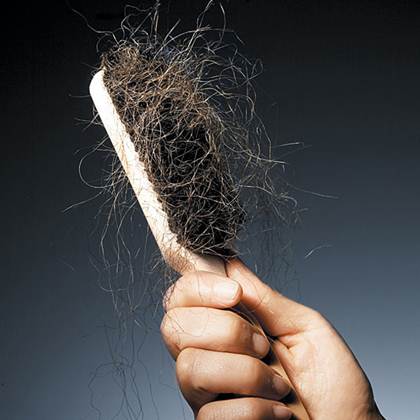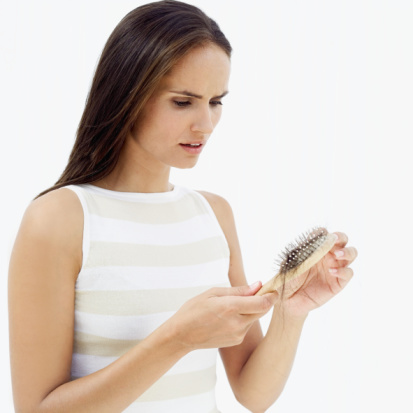
First,
don’t panic
In 1981, 26 year old Debbie Pond of
Toronto was having her thick, curly dark tresses trimmed when the snipping of
her stylist friend’s scissors suddenly paused. “She said, ‘Oh, Debbie, you have
two bald spots,’ “Pond recalls.
Those smooth spots on her scalp turned
out to be a sign that Pond, the newly married and only a few years into her
career with the RCMP, had developed a condition called alopecia areata.
“Alopecia is just the medical term for
hair loss,” notes Dr. Ian Landells, a St. John’s dermatologist and president of
the Canadian Dermatology Association. “There are many, many different types of
alopecia.”
In alopecia areata, which affects an
estimated one to two per cent of the population, the characteristic bald patches
(which can occur on any area of the body) are a result of damage due to
misguided immune system attacks on hair follicles. (A follicle is the sac-like
structure from which a hair root sprout.). While technically an autoimmune
disease, unlike many of its relatives, alopecia areata doesn’t cause physical
pain or disability, confining its path of destruction to the hair and,
sometimes, the nails. (Pitting of the nails; brittle, vertically ridged nails;
and concave, spoon-like depressions in the nail are some possible clues.) Nor
does it necessarily signal the presence of more dire diseases, though eczema
and thyroid disease seem to be somewhat more common among people with alopecia
than they are overall.
“For the most part, alopecia
areata is not
associated with other autoimmune problems,” says Dr. Marni Wiseman, a
Winnipeg dermatologist and assistant professor at the University of
Manitoba and Cancer
Care Manitoba.
Mind you, that doesn’t mean the
condition can’t cause significant harm. Because hair plays such an important
role in appearance, and the way we present ourselves to the world, suddenly
losing it can be very distressing. “For some people, it can be a substantial
life issue,” Wiseman observes. “Some spend hours trying to cover the bald
spots, or clipping in extensions to cover them.” Often, at least at first,
those affected will report feeling as if everyone is staring, and noticing
either the bald patches themselves or the wig or hairpiece used to disguise them.
“It can be very psychosocially disabling,” Wiseman says. Some people lose their
eyelashes or eyebrows, which can be doubly devastating, according to Dr. Jeff
Donavan, a dermatologist and hair loss specialist at Toronto’s Sunnybrook
Health Sciences Centre.
But, while there’s currently no cure for
alopecia areata, wigs, weaves, and brow tattoos aren’t the only options;
effective treatments do exist.
|
“For the most part, alopecia areata is not associated
with other autoimmune problems,” says Dr. Mami Wiseman
|

Treatment Options
The first, most important step on the
treatment path is to consult a physician experienced at diagnosing different
causes of hair loss, which range from thyroid disorders and nutritional
deficiencies (lack of iron being one potential culprit) to the physical shock
of major surgery, various medications (including some antidepressants and
certain blood thinners), and even skin cancers. What’s more, other, rarer types
of alopecia can cause permanent scarring, and, thus, permanent hair loss.
Consequently, it’s critical to untangle what’s at the root of the shedding and
rule out other, more serious, cause as soon as possible. In the right hands, a
careful history and physical exam are often sufficient to uncover the culprit,
though sometimes, a scalp biopsy is necessary. (One signature sign of the
condition are “exclamation mark” hairs broken hairs that are much thinner at
the base than the tip which are often found at the edges of a bald patch.)
Once a diagnosis has been made,
together, the patient and physician can weigh the various treatment options.
Watchful waiting is one possibility; without any treatment, hair regrowth will
spontaneously occur within a year in up to 80 per cent of cases, though some
people do go on to experience a second episode of hair loss.
If the wait and see approach isn’t
acceptable, the doctor can try one of several methods aimed at stopping the
attacks on the hair follicles. (Scientists don’t understand exactly what
triggers the underlying problem in alopecia areata: one theory is that hair
follicles and the “coat” of a particular virus share a small sequence of
proteins in common, causing immune cells to mistakenly identify the hair
growing sacs as a threat.) “If you can shut that process down, the hair is fully
regrow-able,” Donovan says. Typically, the type of treatment considered will
depend on the extent of the hair loss.
Corticosteroids, which dampen immune
cell activity, are the first-line option, and they work best when used within
two years after the start of shedding, and when hair loss is limited to less
than half the scalp. “Patients can apply creams and lotions at home, and then
come in every four to six weeks for scalp injections,” Donovan explains. “In
about 60 to 70 per cent of patients, that can help grow hair.”
Another plus? Injections are typically
covered by provincial health plans, though the topical variety are not.
However, you extended health insurance plan may pick up the tab.
In addition to the inconvenience and
momentary discomfort, injections pose a small risk of side effects, such as
thinning of the skin, depressions in the scalp (which usually fill in over
time), and tissue damage.